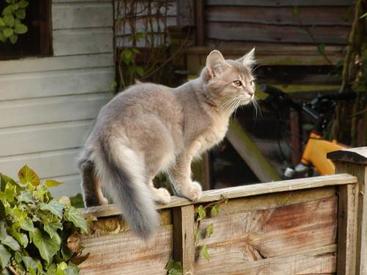
It is uncertain when the Somali cat was brought into existence, although many theories surround its early history. Some claim that the Somali came about through selective breeding of Abyssinians and domestic longhaired cats following the Second World War. When Janet Robertson, a British breeder, transported regular Abyssinians to North America, Australia and New Zealand in the 1940s, she noted that the litters produced by these cats often included kittens with long, scruffy coats. It wasn’t long before these unusual kittens attracted people’s interest and in 1963, Canadian breeder Mary Mailing, asked to enter one of Robertson’s unique cats into a show. The judge of this particular event was so beguiled by the cat that he asked to adopt one for the purposes of breeding. The Somali was recognised by the Cat Fanciers Association in 1979.
Many people think of the Somali simply as a longhaired version of the Abyssinian. The two breeds are similar in many respects besides coat length, from appearance to structure and colouring. The Somali is characterised by a muscular yet athletic build, nimble legs, a plumed tail, large ears and slightly oblique eyes. On the forehead, the tabby ‘M’ marking is seen. The long coat is typically plush and soft to the touch, and requires weekly grooming to maintain an un-matted appearance. Various colours are observed in the breed, although not all registries accept the complete colour spectrum. Those that all registries will accept are fawn, cinnamon/sorrel, blue and ‘usual,’ which is otherwise referred to as ruddy. Coat ticking is what gives the cat its distinctly wild appearance.
Generally speaking, the Somali is a playful and bubbly character with a heart of gold. Fiercely devoted to its people and welcoming to strangers, the Somali delights in being an indoor cat and thrives when given plenty of attention and companionship. This cat makes a wonderful family pet, being compatible with children and other house pets, and likes to participate in all activities around the home. Many have described the cat’s natural love of hair and its tendency to stroke its owner’s beard or perch on its owner’s head. On average, a healthy adult Somali will weigh in the region of 6-9 pounds, with a typical life expectancy of 9-15 years.
The Somali is generally healthy and resilient, although certain health conditions are documented in the breed. These range from mild to more severe. The Somali is prone to gingivitis and related dental complaints so observing good dental hygiene practices is essential. It is also susceptible to pyruvate kinase deficiency, a hereditary condition, a neuromuscular disease known as myasthenia gravis, and progressive retinal atrophy, an eye complaint that can lead to blindness.
Do you own a Somali? Let others know what they're like!
Related products
Advantage 80 Spot On Flea Control Large Cats and Rabbits
from £12.95
Advantage 40 Spot On Flea Control Cats, Small Dogs and Rabbits
from £12.95
Advantage 100 Spot On Flea Control Medium Dog
from £12.95
Advantage 250 Spot On Flea Control Large Dog
from £12.95
Drontal Tasty Bone Wormer Tablets for Small & Medium Dogs (2 to 20kg)
from £2.15
FRONTLINE Plus Flea & Tick Treatment Dogs & Cats
from £17.49
TermaWorm™ Tablets for Cats & Dogs
from £1.59
Drontal Tasty Bone XL Wormer Tablets for Large Dogs (Over 20kg)
from £6.39